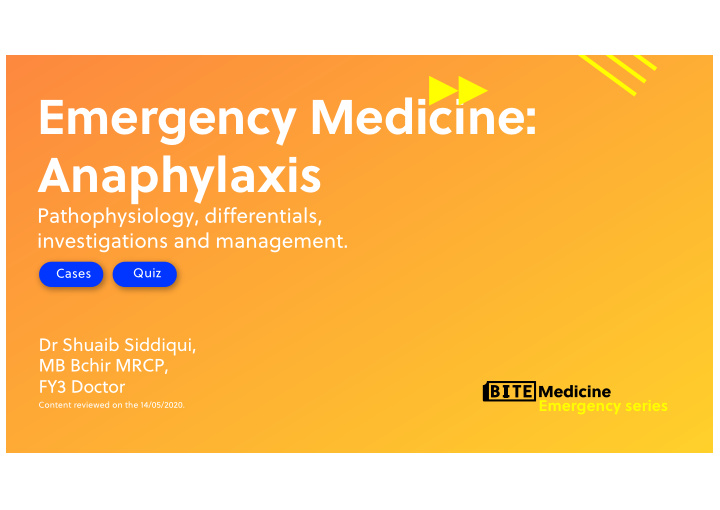



Emergency Medicine: Anaphylaxis Pathophysiology, differentials, investigations and management. Cases Quiz Dr Shuaib Siddiqui, MB Bchir MRCP, FY3 Doctor Emergency series Content reviewed on the 14/05/2020.
Case 1 History A 13-year-old boy attends the emergency department by ambulance, accompanied by his worried parents. His parents reveal he suddenly became wheezy whilst at a birthday party. He was unable to speak due to a swollen tongue. On examination, he is blue in the face with audible stridor. There is an urticarial rash on his trunk Observations HR 140, BP 88/45 mmHg, RR 28, SpO2 87%, Temp 37.2 2
Question 1 3
Question 2 4
Case 1 History A 13-year-old boy attends the emergency department by ambulance, accompanied by his worried parents. His parents reveal he suddenly became wheezy whilst at a birthday party. He was unable to speak due to a swollen tongue. On examination, he is blue in the face with audible stridor. There is an urticarial rash on his trunk Observations HR 140, BP 88/45 mmHg, RR 28, SpO2 87%, Temp 37.2 5
Question 3 6
Question 4 7
8
Pathophysiology Definition: rapid onset , life-threatening changes to airway, breathing and circulation due to a hypersensitivity reaction. (1) 9
Degranulation Pathophysiology Pathophysiology 1. 2. 3. Life-threatening Bronchospasm Hypotension laryngeal & increased oedema mucous membrane secretion Stridor Wheeze Anaphylactic (+ respiratory shock (+ respiratory distress) distress) 10
Differential diagnoses Pathophysiology Allergic reaction Anaphylaxis Anaphylactoid • IgE mediated IgE mediated Not antibody mediated • Non IgE mediated Requires sensitisation Requires sensitisation Can occur on first exposure Systemically well ABC compromise ABC compromise 11
Question 5 12
Pathophysiology Definition: rapid onset , life-threatening changes to airway, breathing and circulation Pathophysiology due to a hypersensitivity reaction. Epidemiology • 0.3% of people experience anaphylaxis in their lifetime (NICE) • Mortality < 1% Risk factors • History of atopy: asthma, eczema, allergy • Food is a common allergen in children • Drugs are a common allergen in adults • Previous anaphylactic reaction • (Hygiene hypothesis) 13
Clinical features Pathophysiology Symptoms Signs Exposure to allergen Hypotensive and tachycardic Angioedema : Tachypnoeic • Swelling of the face, tongue, larynx, genitalia, hands and feet Pruritis and rash Stridor Dizziness Urticarial rash Syncope
Clinical features Pathophysiology (2)
Clinical features Pathophysiology (3)
Question 6 17
A-E assessment Airways • Assess airway patency by asking patient to speak • Listen for evidence of obstruction e.g. stridor • Start with airway manoeuvres, such as a head tilt before airway adjuncts (4) (5) 18
A-E assessment Breathing – Rule of 5 1. Observations: Respiratory rate, oxygen saturations Peripheral cyanosis 2. Peripheral exam: Tracheal deviation, percussion, auscultation 3. Central exam: ABG, CXR 4. Urgent investigations: 5. Management: Oxygen therapy, nebulised therapy 19
A-E assessment Circulation – Rule of 5 1. Observations: Heart rate, blood pressure, fluid status 2. Peripheral exam: CRT, pulse 3. Central exam: JVP, central CRT, auscultate 4. Urgent investigations: ECG, cannula, bloods 5. Management: Fluids, vasopressors 20
A-E assessment Disability 1. GCS 2. Pupils 3. Glucose Exposure 1. Top to toe examination of the patient 21
Question 7 22
Question 8 23
Adrenaline Airway • Alpha agonist à vasoconstriction leads to reduction in laryngeal oedema Breathing • Beta 2 agonist à bronchodilation Circulation • Beta 1 agonist à increased cardiac contractility • Alpha agonist à vasoconstriction Termination • Beta 2 agonist à inhibition of mast cells • Histamine antagonist 24
25
Anaphylaxis protocol Airways • The patient has stridor Dose: 0.5ml 1:1000 (0.5mg) • Attempt airway manoeuvres • 1:1000 = 1g in 1000mls = 1000mg in 1000mls = 1mg in 1ml • Give adrenaline Breathing 1. Observations: RR 28, 87% O 2 2. Peripheral exam: cyanosed 3. Central exam: cyanosed, wheeze 4. Urgent investigations: CXR 5. Management: High flow oxygen 26
Question 9 27
Anaphylaxis protocol Circulation 1. Observations: 88/45mmHg, HR140 2. Peripheral exam: weak pulse 3. Central exam: central CRT 4 seconds 4. Urgent investigations: cannula and bloods 5. Management: IV access and bloods Disability – patient may be unconscious Exposure – may find a rash 28
Question 10 29
30
Question 11 31
Investigations Primary investigations: Pathophysiology • Mast cell tryptase 1) Immediately after treatment has commenced 2) 1-2 hours post-reaction 3) 24 hours post-reaction Outpatient investigations to consider: • Skin prick test • Skin patch test • Radioallergosorbent test (RAST) • Challenge test: contraindicated in anaphylaxis 32
Skin prick test Skin patch test Pathophysiology • Diluted food/pollen allergy is • Multiple allergens taped to the back • Assess for contact dermatitis after placed on skin and pierced with 48h needle • A wheal develops after 15 mins (6) (7) 33
Question 12 34
Complications Biphasic reaction : Pathophysiology • Symptoms may return, usually within 6 hours of the initial episode, without re-exposure to allergen Cardiorespiratory arrest : • Food: 30 mins • Insect sting: 15 mins • Medication: 5 mins Recurrence : • A previous episode of anaphylaxis correlates with an increased risk of a future anaphylactic reaction 35
Top decile question 36
Further information We need your feedback and support! Release new lecture schedules every Saturday New, interactive website coming very soon Want to get involved? Contact us at opportunities@bitemedicine.com to get your information pack Stay up-to-date! • Website : www.bitemedicine.com • Facebook : https://www.facebook.com/biteemedicine • Instagram : @bitemedicine • Email : admin@bitemedicine.com 37
References 1) Paweł Kuźniar (Jojo_1, Jojo) [CC BY-SA (http://creativecommons.org/licenses/by-sa/3.0/)] 2) James Heilman, MD / CC BY-SA (https://creativecommons.org/licenses/by-sa/3.0) 3) James Heilman, MD / CC BY-SA (https://creativecommons.org/licenses/by-sa/3.0) 4) Another-anon-artist-234 / CC0 5) ICUnurses / CC BY-SA (https://creativecommons.org/licenses/by-sa/4.0) 6) Wolfgang Ihloff / CC BY-SA (https://creativecommons.org/licenses/by-sa/4.0) 7) Jan Polák / CC BY-SA (https://creativecommons.org/licenses/by-sa/3.0) All other imag ages ar are from Shutterstock (bas asic license) or mad ade by Bi BiteM eMed edicine an and not ap appropriate for redistribution. 38
Recommend
More recommend